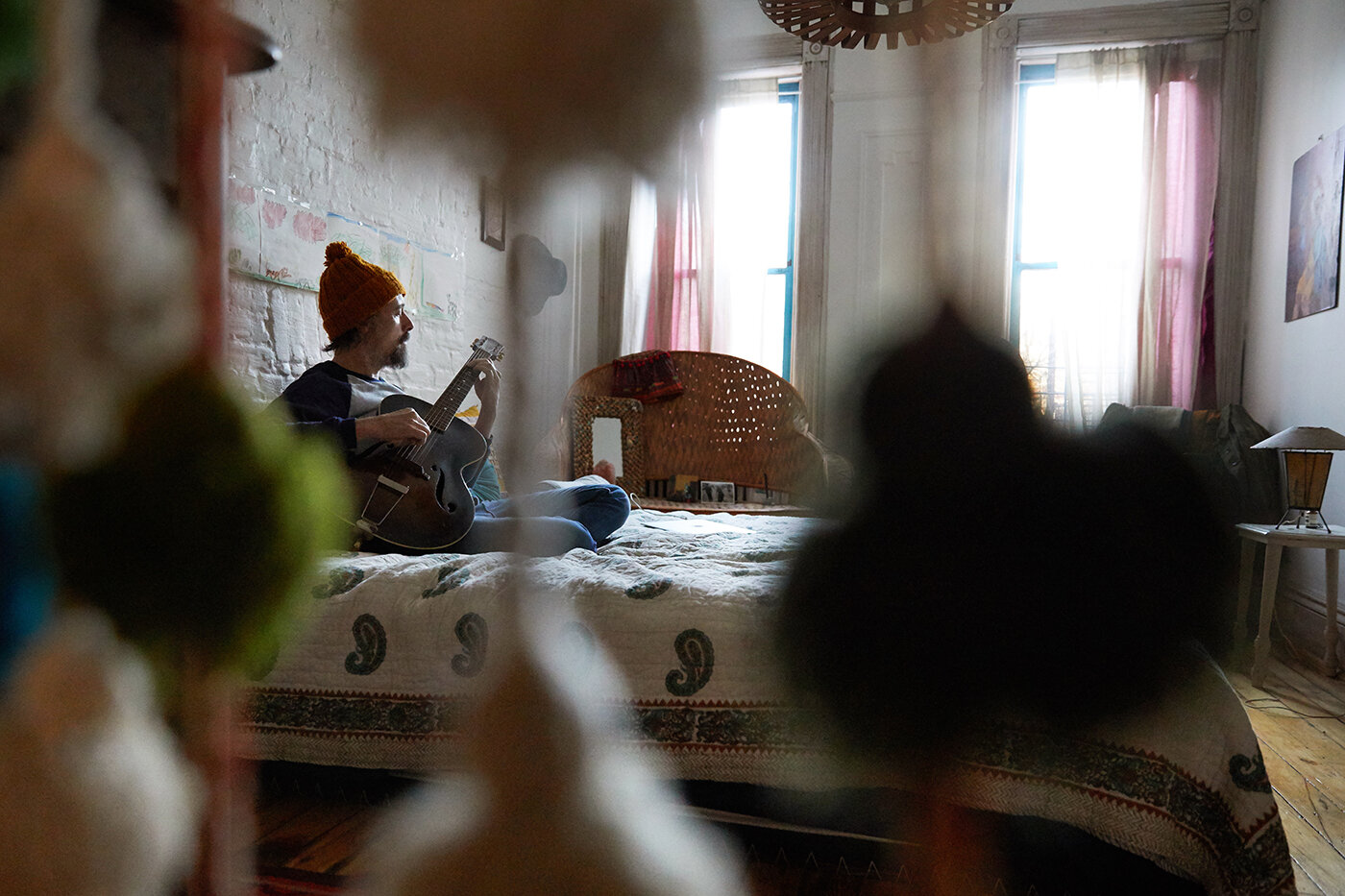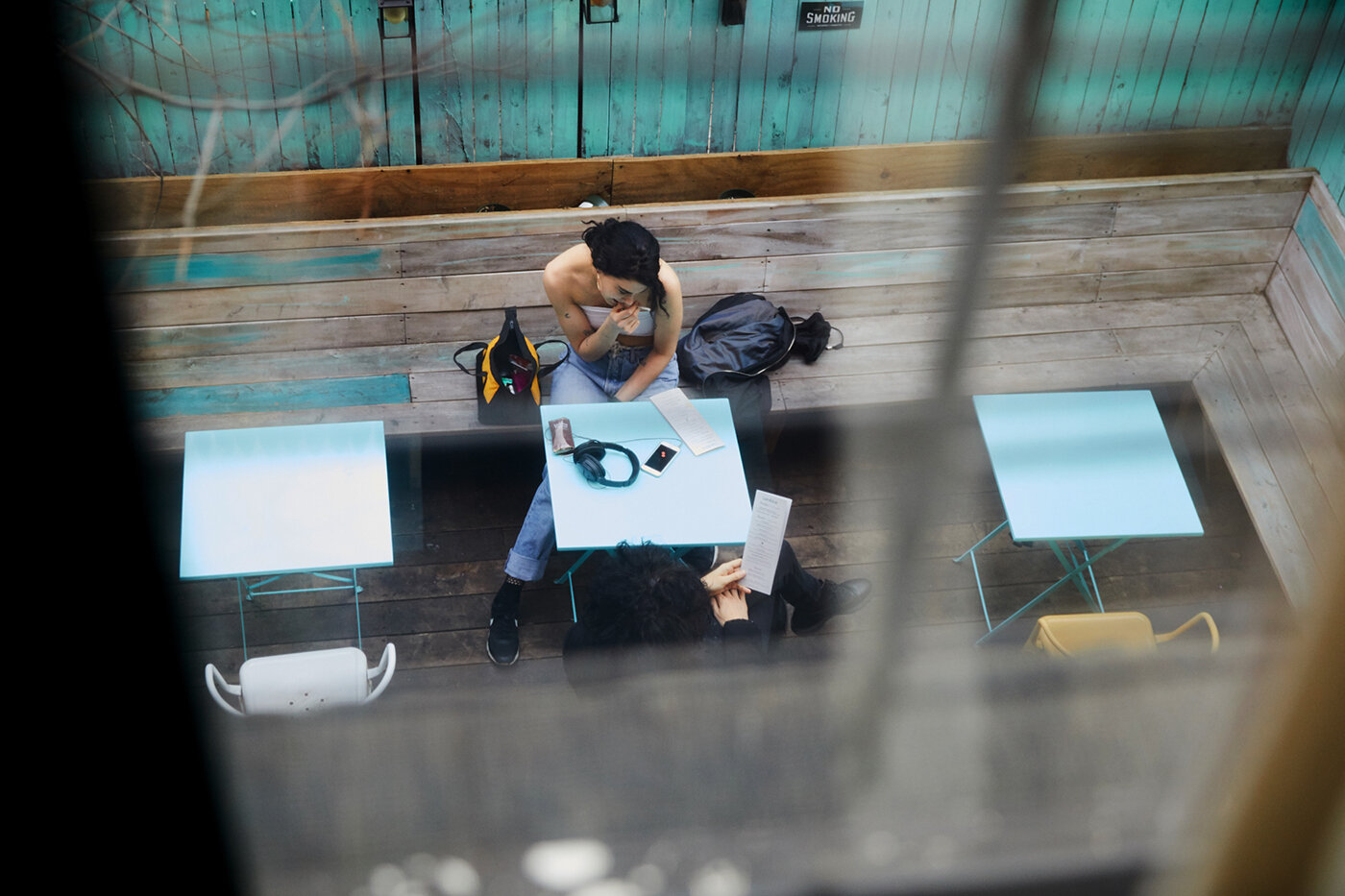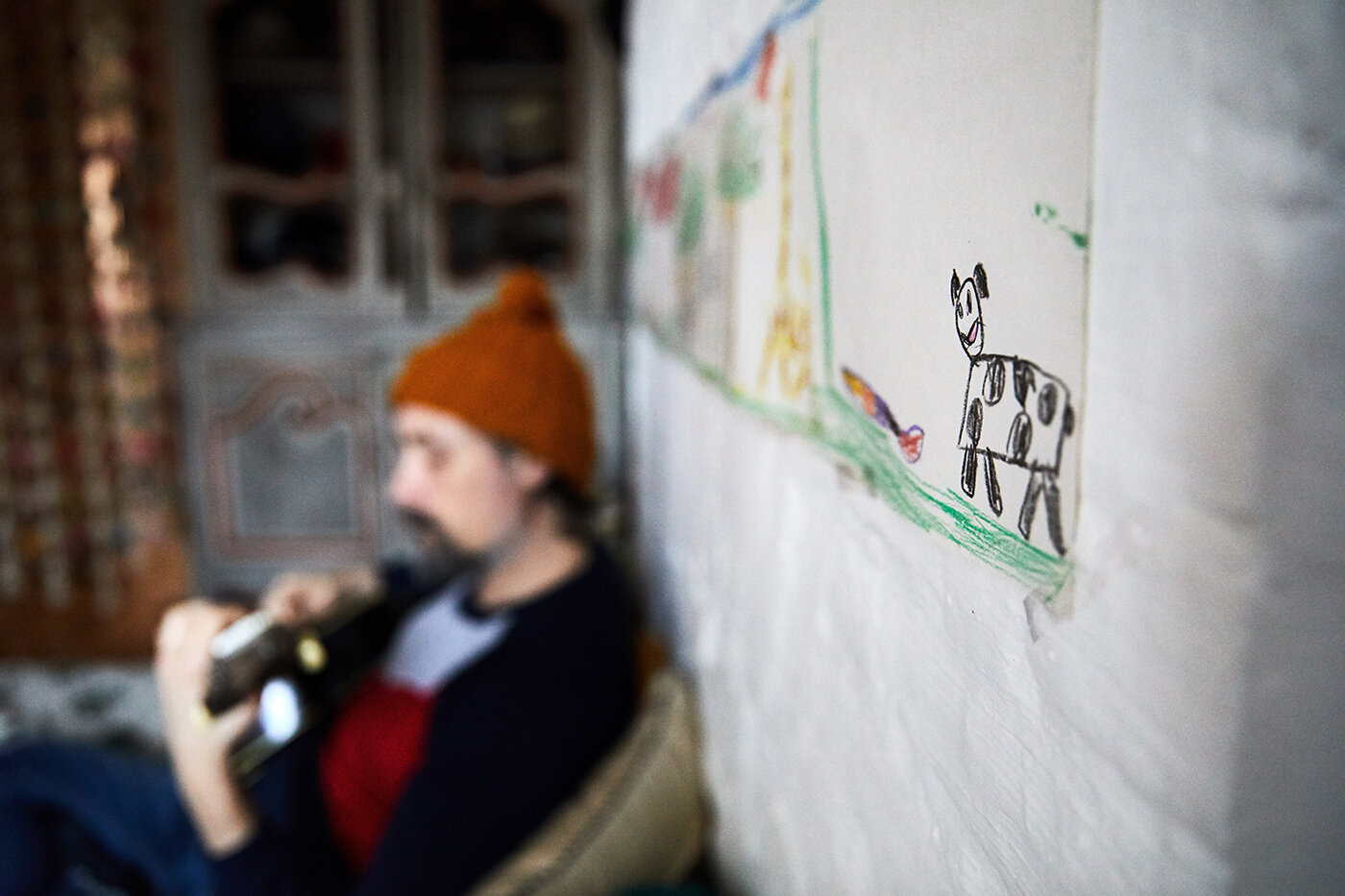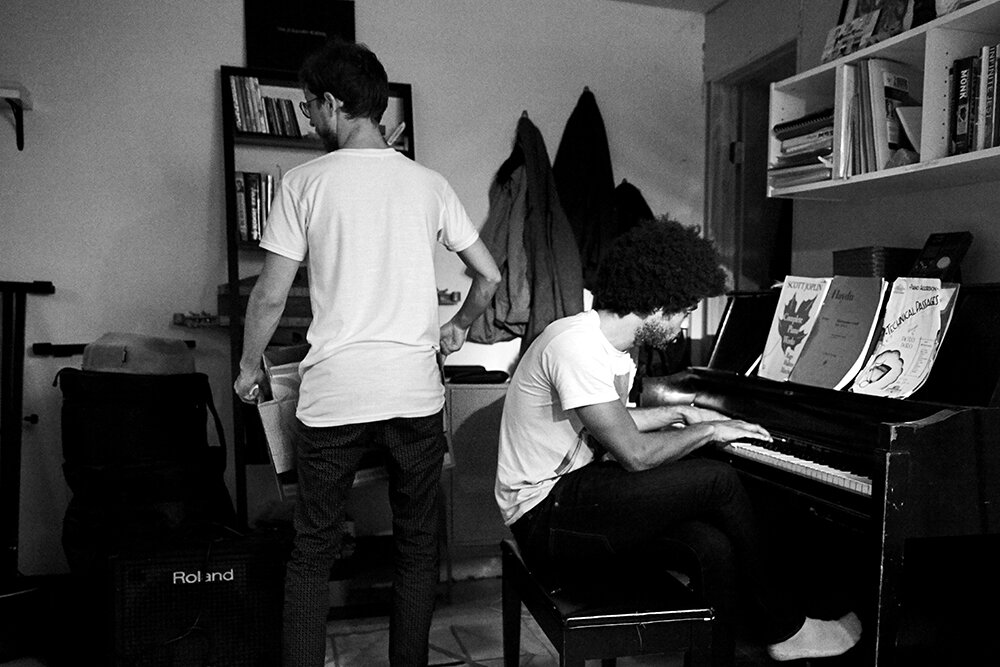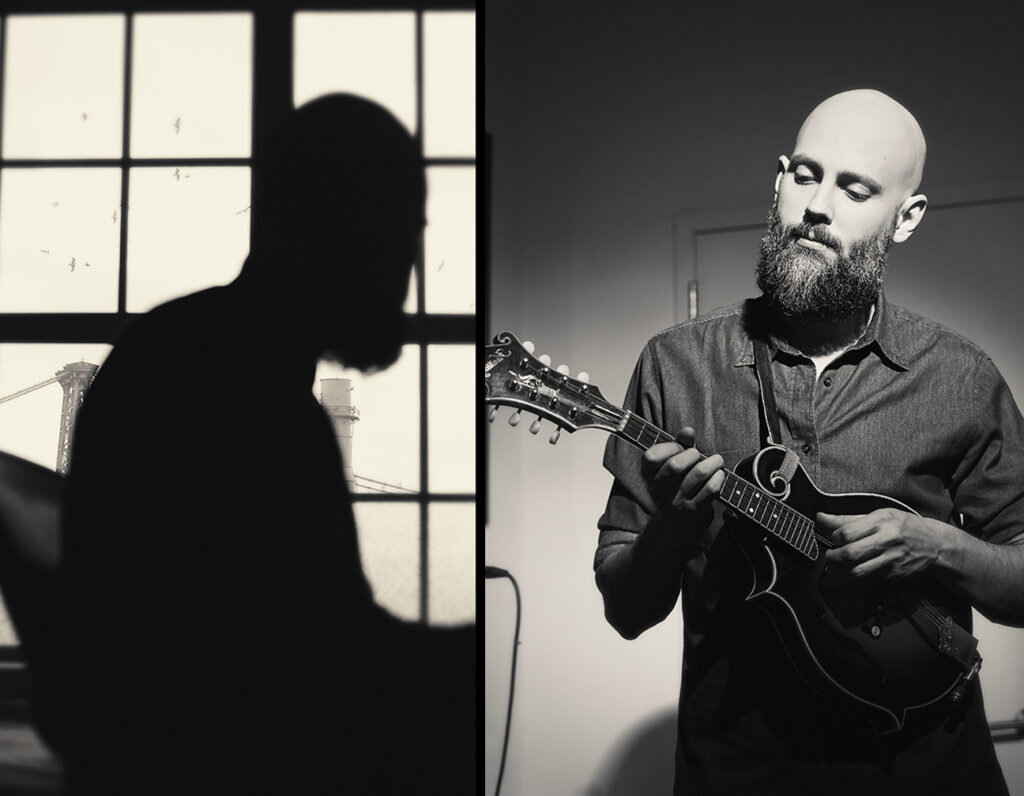Richard Julian: A Creative Space Built on Music
A few weeks ago I met up with Richard Julian, singer songwriter and co-owner of Bar Lunatico, in his apartment up the stairs from the bar. Walking up the spiral staircase, a home emerges. In a little room off the corner of the stairs is Richard's writing room. It hosts a little desk covered in a flurry of items (rare mezcal recently gifted, a gumbo cookbook, papers, and an old photograph of Duke Ellington, amongst other things). Richard usually works sitting on the day bed with his grandfather's 1920s guitar in hand.
Although he hasn't put out any new albums in the last few years since his son was born, he is constantly writing down ideas in his notebook. At the end of the book, when the pages have been filled, he'll go through and catalog the ideas that hold the most promise on the last page: an index of references for future songs. When I asked him if there are certain themes that he finds himself being drawn to, he thought for a moment and answered "sex" and "melancholia" ((and then jotted it down in his book because it had a nice ring to it). He expanded saying it's more of a constant pursuit of introspection, an effort to understand the significance of memories, places, and things that seem to never let him go. He is drawn to those unbridled emotions where people are most raw and uninhibited. His songs are carefully crafted portraits of people and places, draped with a coat of wittiness and observation.
Richard initially moved to NYC from his home state of Delaware in the 80s after a brief stint playing keyboards in the lounges of Las Vegas. He lived in Hells Kitchen for 20 years, and watched the neighborhood transform outside his window. Richard has long dreamed of owning a music bar, the perfect expression of his love of music and cocktails. After living in New Orleans for a few years with his wife and fellow songstress, Rosita Kess, he moved back to NYC with one stipulation, that they would finally open the bar they always dreamed of. It was not an easy journey, and finding the right location took much searching. In the end they found and built a haven for NYC musicians and patrons alike with a hint of New Orleans spice.
Having Bar Lunatico downstairs is like having a party that you're always invited to. On the days when Richard is not working, he may come downstairs, take in the atmosphere, and hang with the musicians. And on the days when he needs some downtime, he stay upstairs and listens to the music in the privacy of his home. In any case, music is always in the air on Halsey St.
When Richard showed me around the apartment, I also had the chance to see his five year old son, Floyd's, room. As a mom myself with a two year old son, it left a deep impression on me. The doors to the closets were covered in Floyd's elaborate animal drawings. Books and toys lined the corners of the bed, which had an animal duvet cover on top. I asked Richard what Floyd's impressions have been growing up with so much music around. Richard laughed and showed me that at the head of Floyd's bed are heating pipes that go directly downstairs to where the stage is at the bar. Every night Floyd falls asleep, listening to the sounds of incredible musicians playing. 'He has never once complained,' Richard said.
As a mom trying (sometimes desperately) to raise a child that is sweet, kind and curious, I often wonder which experiences in my son's life will hold the most meaning. What will shape his personality and tastes in the future? Getting a glimpse into Floyds room, I couldn't help but feel like this kid is going to grow up to be an incredibly interesting person. In building a music bar for themselves, Floyd's parents have given him a beautiful gift, a creative space of his own.
Explore Richard Julian’s music:
Facebook: Richard Julian
Website: http://www.richardjulianmusic.com/index1.php
Spotify: Richard Julian
Josch Chodakowsky’s Library of Sounds and Inspiration
I'll be honest, I have never thought about the term nor the concept of ethnomusicology until I photographed Josch Chodakowsky in his apartment in Ditmas Park a few months ago. Josch (aka DJ Inbetween) is a DJ and composer- more specifically a sound collage-r, creating music by sampling elements from written songs to create completely unique songs. Josch's living room contains a library of about 10,000+ records, spanning the decades and continents. He has always had a fascination with the history of music and began collecting records at a young age. It should come as no surprise that Josch's educational background is in Library Science and aside from composing and DJing, he works as a researcher during the day. But his true love of DJ'ing began while he was still in school, circa mid-1990s, when he and his friends would gather to listen to the latest hip hop records and attempt to sample their first songs.
Facing the giant wall of records, I couldn't help but feel overwhelmed. Where would you even start when you have a universe of sounds at your disposal? When I asked Josch, he said for himthe creative process is a bit like "lightning in a bottle". He began pulling records out to show me how ideas would turn into songs, picking out a bass line here or the first measure off of another record, and programming those so that a song began to emerge. Most of the samples were completely unrecognizable and he purposefully choses songs that are obscure so that the listener doesn't form associations with that sound. Each time he pulled a record, on to the turntable it went, quickly and without hesitation. Then, when the piece he wanted to play was over, back into the library they went, sometimes to a different spot than where they came from - a reflection of the organization that only he was privy to. It reminded me a bit of a cook in the kitchen, grabbing a pinch of this spice and that, stirring around and tasting the sauce to see what else was missing.
Within the confines of the concept of musicianship, what Josch creates might not be considered making music because he's not actually playing or composing with an instrument. However, to me, it absolutely embodies the term. To create a unique song by connecting dozens or hundreds of already written elements of music, is still in its essence composition and it is incredible to see these stretches of creativity and the capabilities of sound. A postmodernist approach to making music, and one that weaves together society and culture at that moment in time.
For Josch, collecting records is a bit like archeology; an examination of the significance of music in our culture and the tracing of the roots of modern music to their points of inspiration. His appreciation of music is infused with an innate curiosity of piecing a puzzle together that is in fact never ending. When he hears something that strikes him, for example an interesting bass line, he will often look up the musician, find the other records they played on, research what influences they had, and then delve into the music of those influencers, and so on and so on until a musical family tree of inspiration begins to emerge.
Although Josch's musical inclination is towards early Funk, Soul and Hip Hop, his research extends far across the globe. He told me he would go through phases when he would delve into a certain country's music and dig deep into their history, often piecing the significance of the artist in that country's moment in time. And often, when he embarks on a particular country's music history, he learns how to play the musical instruments native to the country so that he has a deeper sense of the music.
When it comes to record collecting, the rarer the record, the more exciting. "If the apartment was on fire, this is the box I would take with me" he said as he pulled out a "Supercase" of 45's. Gently he took out a record by The Third Guitar with "Baby Don't Cry" on it and laid it on the turntable. In the process, showing me the tattoos on his forearms which replicated the album's label. What made these particular records so sought after? Josch explained that some of the records in the Supercase were rare because they were the original albums that had been sampled by famous songs, in other cases, they were records made by unknown bands of which there were only a limited number of copies pressed. I asked him why it would be matter if a completely unknown band had put out a limited number of records. But he explained that for collectors, the thrill is in finding that incredible and undiscovered record from an unknown band. A stroke of luck and/or determined investigation.
Explore Josch Chodawsky’s music: Facebook: https://www.facebook.com/joschchodakowsky Mixcloud: Www.mixcloud.com/djinbetween Soundcloud: https://soundcloud.com/dj-inbetween IG: @djinbetween
Trumpeter Wayne Tucker in his Crown Heights creative space
A few months ago, I had the pleasure to photograph trumpeter Wayne Tucker in his Crown Heights apartment that he shares with four other musicians. We began by talking in his living room. There in the middle of the room, Wayne conducts his daily practice, a combination of meditative breathing and trumpet playing. Closing his eyes, he counts to 10 in his head and clears his mind of everything except the even nature of his breath. He holds each note as long as possible while trying to maintain the same intensity. This practice allows him to channel all of his energy into his playing, a technique he later uses when he's onstage. When performing, he listens to the energy of the room and tries to concentrate on it, focuses all his effort on the energy coming out of him and into the audience.
Wayne comes from a family of musicians; his father, a piano player, was the main influencer of his musical taste, exposing him to funk, soul and r&b from an early age. Naturally, Wayne's first instrument was the piano, then he learned to play the violin, and finally the trumpet. His older brother (who is one of the four musicians he currently shares an apartment with), plays the tenor sax. In fact, it was after his brother began playing the saxophone, that Wayne picked up the trumpet. He grew up with a built in band at home, often jamming and experimenting from a young age.
Wayne spent a long time studying the technicalities and the math behind the music, including the patterns and permutations, to the point that it can become instinctual, allowing him to focus on evoking the feeling behind the music. In high school, he was part of an orchestra, which allowed him to understand composition and gave him an ability to hear all the elements in a song. That experience fueled his musical passion, the search for beautiful harmonies.
His latest album "Wake Up and See the Sun" (released this September), is about appreciating what one has in life. He is drawn to using music as a vehicle to transport the listener to a specific place or feeling. A way to share his world with others. Many of the songs on the record had been written years ago, but he wanted to take the opportunity to explore them musically, incorporating different instrumentations and sounds to create an eclectic sound quilt for the listener.
When I asked Wayne how he composes songs, he shared that it always starts with the piano, and as the song builds, he finds the natural moments where the trumpet can come in. So we went downstairs, to his roommate's (David Linard) room where there is a stand up piano. While his roommate was packing to go to rehearsal, Wayne started fiddling with the keys, experimenting with a progression of notes he played over and over. I asked him what he was thinking of as he was doing this, and he said it reminded him of being in church. The first time the pastor says "Jesus" it doesn't really have much of an effect on you, but slowly as he repeats the name over and over, the word starts to take on a meaning. So do the progression of notes as he plays them over and over, until a melody begins to emerge...
Explore Wayne Tucker's music: Facebook: https://www.facebook.com/wayne.tucker.73 Spotify: Spotify IG: @wayneeverest
“The Point of Inspiration” with composer and songwriter Joy Askew
I met up with composer and songwriter Joy Askew on a Sunday afternoon in her Bed Stuy apartment where she's lived for the last 9 years. Joy is originally from Newcastle, England but has lived in New York since coming here in the 80's. Joy's creative space is her bedroom; she converted it into a studio with her piano, keys, and various recording equipment sharing the space with a bed and dresser. Joy's most recent record, Queen Victoria, was inspired by a memory from her childhood when she was a young girl and heard the sound of a brass band playing in the distance as it was approaching her home. This figment of an idea later came to take shape in the form of an album. Joy composed the album with a brass band in mind and was able to travel to England to record the 30-piece Brighouse & Rastrick Band. A "flock of birds" coming together to create an incredible sound.
When we spoke about inspiration and creativity and how Joy gets her ideas, she shared that usually there's a spark of an idea and sometimes it's just a matter of following it down the rabbit hole. There is always a concept to her albums. Some of her prior albums were inspired by the specific tuning of Joni Mitchell's guitar or the deconstruction of famous jazz songs which lead to the downbeat electrojazz album she worked on with multiinstrumentalist, Takuya Nakamura. Regardless of the idea, there is an effortless and spontaneous nature to her creativity, one that she allows to form without questioning its connection to her established path or sound.
Before ending our session, Joy mentioned something that I have not been able to get out of my head ever since. When she was asked to deliver a songwriting lecture at Berklee College of Music on the topic of what makes a good chorus, she analyzed her top 50 songs across the decades to come up with the elements that made these choruses successful. After all, she said, it is usually in the chorus that you can find the point of inspiration for the song. Perhaps to most musicians this is not news, but to me it was an incredible discovery. To think that you can find the nugget for the song in the chorus, was like unlocking the viewfinder into the songwriter's head.
Why am I so interested in this idea? Because it feels like the key to understanding art. Not by asking the artist (especially when we don't often have the chance to do so) but by experiencing the art itself.
For me, my point of inspiration for this project is inspiration itself. Where is creativity derived from? I don't know what my ultimate goal is in this search for inspiration, but perhaps if you know the path of creativity you can somehow tap into it. Without art and beauty and inspiration, we're just skin and bones and blood (thanks Niall). Bodies in motion instead of beings.
Explore Joy Askew’s music: Website: Joy Askew FB: Joy Askew IG: @JoyAskewMusic
Sound Engineer Will Hensley in his Williamsburg home studio
If you're a NY musician, you probably met Will already so no introductions are needed!
For the rest of you, Will Hensley is an incredible musician and sound engineer. He has worked with many of New York’s musicians, either playing or mixing and mastering their music. I was excited to work with him because I really wanted to know more about his creative process and how his finely tuned ear allows him to take an artist’s vision for a song and make it happen. I only wish it would be possible to get inside his head to hear what he's hearing!
Will lives in an apartment in Williamsburg, BK and works mainly out of his bedroom. This is his creative space. He said he used to work out of a studio that he rented but realized there was no point in doing so when he could do the same work out of his home. He sound proofed his room including his closet to allow him to record different instruments in there (leaving only a small sliver of space for his shirts to hang). The rest of his space is minimal, with only a bed, and the rest is taken up by engineering equipment and instruments (some of which he made himself!).
He was working on a new mix for an artist while we were photographing, and as the song played in the background, he grabbed the guitar and started playing along, creating and improvising a beautiful melody to go along with the song. You could feel his complete immersion in it.
Here's how you can find Will Hensley: Website: http://wahproductions.com/ Email: will@wahproductions.com
How the “Creative Spaces of NYC Musicians” series began…
Almost six months have passed since I started working on the Creative Spaces of NYC Musicians photo series, and now I have come to realize that the project needs a voice and a place where that voice can be heard! This blog is my own space where I can explore the ideas of creativity in a deeper way and highlight some of the wonderful artists of New York City and what inspires them to compose. I think I should start at the beginning - how I came to start working on the series. To say that I had it all planned out would be lying. It has very much been a work in progress, changing its shape and incorporating new ideas as they come. I have always been fascinated by the phenomenon of inspiration and the form it takes. What sparks an idea? Where does this elusive thing come from? How much does the space that we occupy inform our creativity?
I wanted to work with musicians because well...I love music. To me, music is the most visceral art form, it has the capacity to make people feel in such a powerful way, it's effect is undeniable. I have always grown up with musicians in my family, and later went on to marry a musician, so in some ways my life has always had a soundtrack. Given this experience, I have always loved watching new songs be written (even now as I write this my husband is writing a song 3 feet away from me). To hear the spark of an idea, a nugget that sounds like it could become something, develop in front of you, is fascinating.
And the spaces part? That came about because living in New York means that space is a highly prized commodity! The city can be so overwhelming with its energy, that each one of us struggles to establish a small slice of peace in our home where we can let down our city guard and be ourselves. Because our living quarters are small, NYC is a city where people often go out, rather than meet in their homes. As a result, we don't often get to see each other's private spaces.
This project has changed that for me and I feel incredibly honored for the opportunity to be welcomed into the homes and intimate corners where musicians write and work on their craft. The conversations I end up having and the raw moments that they share with me is a gift I cannot repay. I only hope that through the images in the Creative Spaces series, I can share their talent and their world with others.









